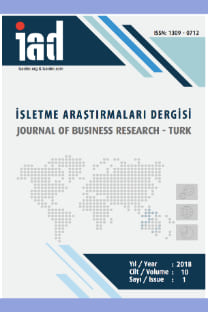Pay Getirilerinin Basıklık ve Çarpıklığının İflas ve Temerrüt Olasılıkları Üzerine Etkisi
The Effect of the Skewness and Kurtosis of Stock Returns on the Bankruptcy and Default Probabilities
___
- Aktaş, R. (2003). Mali Başarısızlığın Öngörülmesi: İstatistiksel Yöntemler ve Yapay Sinir Ağı Karşılaştırılması. Ankara Üniversitesi SBF Dergisi, 58(04)
- Altman, E. (1968). Financial Ratios, Discriminant Analysis and The Prediction of Corporate Bankruptcy. The Journal of Finance, 23(4): 589-609
- Baesens, B., Roesch, D. ve Scheule, H. (2016). Credit risk analytics: Measurement techniques, applications, and examples in SAS . John Wiley & Sons.
- Bali, T. G., Mo, H. ve Tang, Y. (2008). The role of autoregressive conditional skewness and basıklık in the estimation of conditional VaR. Journal of Banking & Finance, 32(2), 269-282
- Bali, T. G. ve Theodossiou, P. (2007). A conditional-SGT-Va approach with alternative GARCH models. Annals of Operations Research, 151(1), 241-267
- Beaver, W. H., McNichols, M. F. ve Rhie, J. W. (2005). Have financial statements become less informative? Evidence from the ability of financial ratios to predict bankruptcy. Review of Accounting Studies, 10(1), 93-122
- Beaver, W. H. (1966). Financial Ratios as Predictors of Failure, Journal of Accounting Research, 4: 71-111
- Beaver, W.H., Ketler, P. ve Scholes, M. (1970). The Association Between Market Determined and Accounting Determined Risk Measures. The Accounting Review, 45(4): 645-682
- Berk, J. ve DeMarzo, P. (2017). Corporate Finance, Global Fourth Edition. Essex: Person Education Limited
- Bharath, S. T. ve Shumway, T. (2008). Forecasting Default with the Merton Distance to Default Model., Review of Financial Studies, 21(3): 1339-1369
- Bozkurt, İ. (2014). İflas Olasılığı ile Sistematik Risk İlişkisinin İncelenmesi ve Etkin İflas Göstergesi Modellerinin Tespiti: BİST’de Ampirik Bir Uygulama. Süleyman Demirel Üniversitesi İktisadi ve İdari Bilimler Fakültesi Dergisi, 19(4)
- Campbell, J. Y., Hischer, J. ve Szilagyi, J. (2008). In Search of Distress Risk. The Journal of Finance, 63(6): 2899- 2939
- Carr, P. ve Wu, L. (2010). Stock options and credit default swaps: A joint framework for valuation and estimation. Journal of Financial Econometrics, 8(4), 409-449
- Carr, P. ve Wu, L. (2011). A simple robust link between American puts and credit protection. Review of Financial Studies, 24(2), 473-505
- Chava, S. ve Jarrow, R. (2004). Bankruptcy Prediction with Industry Effects. Review of Finance, 8(4): 537-569
- Chava, S. ve Purnanandam, A. (2010). “Is default Risk Negatively Related to Stock Returns? Review of Financial Studies, 23(6): 2523-2559
- Duffie, D., Saita, L.ve Wang, K. (2007). Multi-period corporate default prediction with stochastic covariates. Journal of Financial Economics, 83(3), 635-665
- Griffin, J. M. ve Lemmon, M. L. (2002). Book-to-market equity, distress risk, and stock returns. The Journal of Finance, 57(5): 2317-2336
- Hillegeist, S. A., Keating, E. K., Cram, D. P. ve Lundstedt, K. G. (2004). Assessing the Probability of Bankruptcy, Review of Accounting Studies, 9(1): 5-34
- Hosmer Jr, D. W., Lemeshow, S., & Sturdivant, R. X. (2013). Applied logistic regression (Vol. 398). John Wiley & Sons.
- Kulalı, İ. (2014). Muhasebe Temelli Tahmin Modelleri Işığında, Finansal Sıkıntı ve İflasın Karşılaştırılması. Sosyoekonomi, 22(22)
- Merton, R. C. (1974). On the pricing of corporate debt: The risk structure of interest rates. The Journal of Finance, 29(2), 449-470
- Neter, J., Wasserman, W.ve Kutner, M. H. (1985). Applied linear statistical models: Regression. Analysis of Variance, and Experimental Designs, 2nd Edition, Homewood: Richard D.
- Ohlson, J. A. (1980). Financial Ratios and The Probabilistic Prediction of Bankruptcy. Journal of Accounting Research, 109-131
- Shumway, T. (2001). Forecasting Bankruptcy More Accurately: A Simple Hazard Model. The Journal of Business, 74(1), 101-124
- Sun, J., Li, H., Huang, Q. H.ve He, K. Y. (2014). Predicting financial distress and corporate failure: A review from the state-of-the-art definitions, modeling, sampling, and featuring approaches. Knowledge-Based Systems, 57, 41-56
- Ural, K., Gürarda, Ş.ve Önemli, M. B. (2015). Lojistik Regresyon Modeli İle Finansal Başarısızlık Tahminlemesi: Borsa İstanbul’da Faaliyet Gösteren Gıda, İçki Ve Tütün Şirketlerinde Uygulama. Muhasebe ve Finansman Dergisi, 1(17), 85-100
- Vazza, D. ve Kraemer, N. (2012) Default, Transition, and Recovery: 2012 Annual Global Corporate Default Study and Rating Transitions. Standard and Poors Ratings Direct Report, 2012
- Zmijewski, M. E. (1984). Methodological Issues Related to The Estimation of Financial Distress Prediction Models. Journal of Accounting Research, 22: 59-82
- Zhang, B. Y., Zhou, H.ve Zhu, H. (2009). Explaining credit default swap spreads with the equity volatility and jump risks of individual firms. Review of Financial Studies, 22(12), 5099-5131
- ISSN: 1309-0712
- Yayın Aralığı: 4
- Başlangıç: 2009
- Yayıncı: Melih Topaloğlu
Pouya TAHERİ, Necmiye Tülin İRGE
The Impact of Corporate Strategies on Financial Leverage: Evidence From TurkishListed Firms
Burcu DİNÇERGÖK, Ahmed Ibrahim Abdelhadi HOUR
Konut Fiyatları Tüketici Güvenini Etkiler Mi?
Analysis of E-Complaint Management in Glamping Businesses within the Scope of a Case Study
